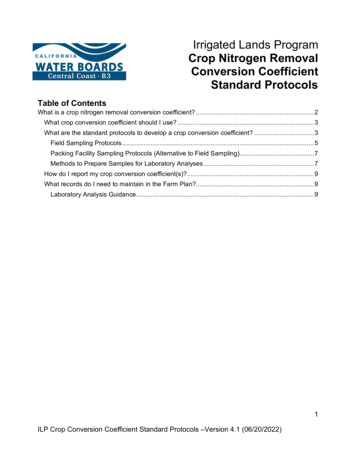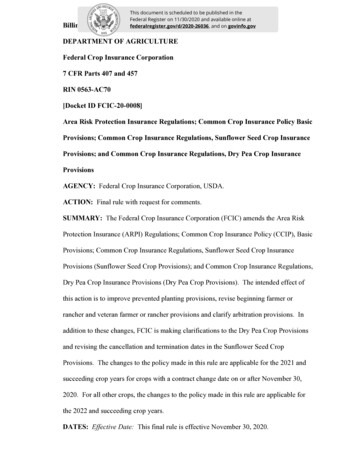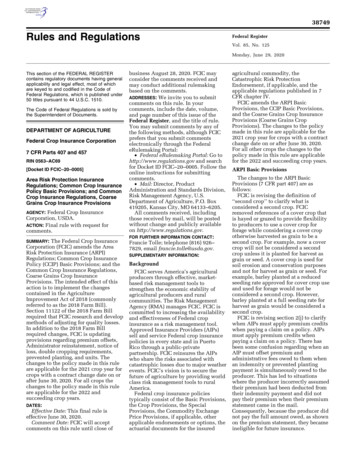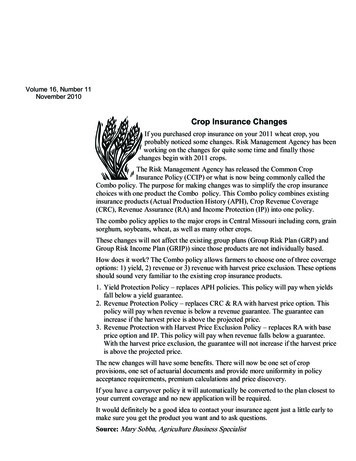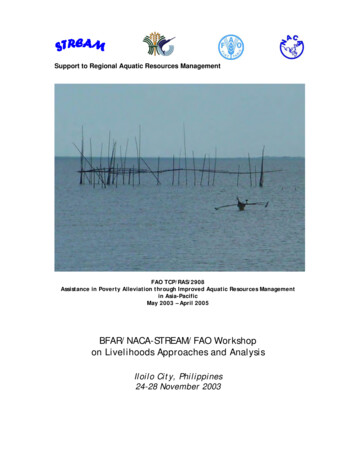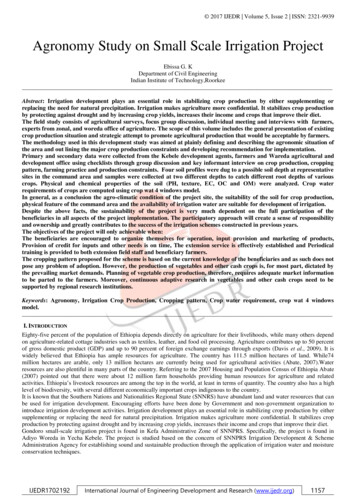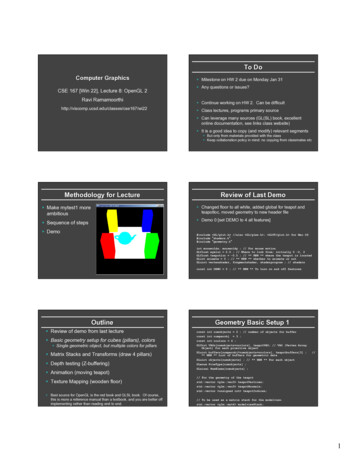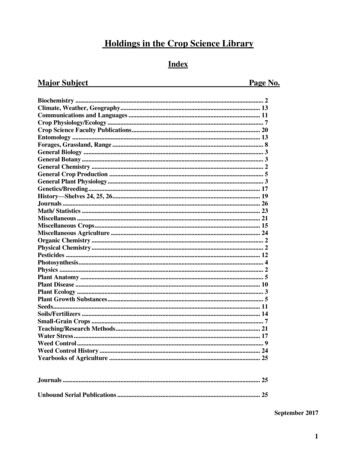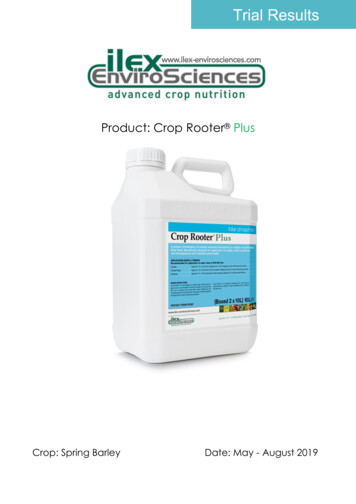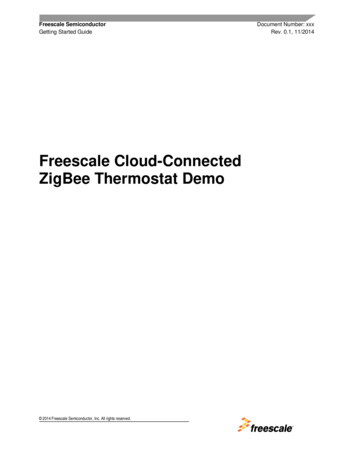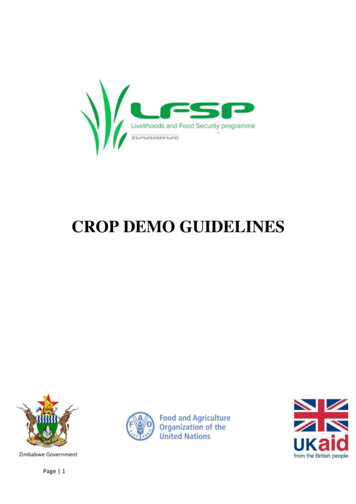
Transcription
CROP DEMO GUIDELINESPage 1
ContentsCROP DEMO GUIDELINES. 3What is a crop demonstration plot? . 3What can we demonstrate on? . 3How do we come up with a demo theme? . 3What do we consider to decide on demo host? . 4What do we consider when choosing a demo field?. 4Do we do treatments in a demo? . 4What size and layout? . 4What should be in a demo record sheet? . 4Who are the stakeholders in crop demos? . 5Roles and Responsibilities . 5Farmers/Community . 5AGRITEX. 5Donors/NGOs . 5Universities, colleges and research stations . 5Interpretation of results . 6What should be in a demo kit? . 6Page 2
CROP DEMO GUIDELINESThe following guidelines have been developed to assist extension staff and farmers to better plan,design and manage crop demonstrations that respond to farmers’ extension gaps. The following aresome of the frequently asked questions to be addressed by the crop demo guidelines: What is a demo?What can we demonstrate on?How do we come up with a demo theme?Which factors do you consider in determining demo host and field?How many treatments should be applied in a demo?How do we design demo layout? What is the optimal size for demo plotsWhat should be in a demo record sheet?What are the roles and responsibilities of farmers and other stakeholders in the democycle?How do you interpret demo results?What constitutes a comprehensive demo kit?What is a crop demonstration plot?A demonstration plot is a field that is used for teaching, sharing ideas and showcasing a provenagricultural practiceWhat can we demonstrate on? Varietal demosManagement – e.g. weeding/herbicide application, pests, etc.New technologies – CA, herbicides, slow release fertilizer application (foliar & tablets)Fertilizer application rates and timingTime of plantingIrrigation methodsCrop rotation( long term)Various climate smart agriculture (CSA) technologies such as in-field water harvestingthrough the use of e.g. zai pits, infiltration pits etc.Improved crop storage technologies.How do we come up with a demo theme? Identify the problem in a particular area. Participatory approaches need to be employed inproblem identification. (Farmer-Extension- Research collaboration). Various participatorymethods such as focus group discussions, pair-wise ranking, problem tree analysis, amongother, can be used to identify problems and farmer priorities.Problems can be initially identified by farmers.It can also be technology that needs to be transferred to farmers for adoption.Page 3
What do we consider to decide on demo host? Someone socially acceptable by the communityAccessible to demonstration stakeholders i.e. physical accessLiteracy level of farmerLabour availabilityFarmer should have a passion for farming/technology naturally, with good previous recordsof good farmingWhat do we consider when choosing a demo field? Have a basic understanding of the history of the fieldEven field (slope etc.)Uniform inherent fertilitySoil should be representative of the areaDo we do treatments in a demo? Treatments not, but comparisonsThese comparisons can be repeated on different sites such as traditional vs improvedmethod e.g. fertilizer demoBest practices can be used to drive the point homeTwo rates can be compared- the recommended rate vs farmer’s practiceFor example variety demo – Landrace (variety being used by farmers) vs Improved varietiesWhat size and layout? Size 0.1 - 0.5haNo designs in demos because it’s not a trialParameters for consideration in positioning a demo include the following: Slope of the land,soil structure, labour availability etc.What should be in a demo record sheet? Location (Ward, village, host farmer, GPS coordinates)The theme of the demoPlot sizePlant spacingPractices carried out (land preparation, liming, fertilizer/manure application, planting,weeding, thinning, etc.), dates and time taken (labour days) and input quantities,Dates for specific physiological stages (germination- 80%, flowering, pegging, silking etc.)Incidences like hail and animal damageCrop growth stagesPests and disease prevalence and control measuresRainfall dataArea, Production and Yield dataGeneral remarks,Page 4
Who are the stakeholders in crop demos? Host farmer/communityFarmer organisations, e.g. ZFU, Commodity AssociationsAGRITEX & other government extension departments.Private sector e.g. fertilizer, seed and chemical companies.ResearchersDonors/NGOs/UN agenciesUniversities, colleges and research stationsLocal leadershipRoles and ResponsibilitiesFarmers/Community Assist in developing the theme of the demo.Provide the labour & other physical inputsProvide landManagementRecordingSecurityEvaluationAGRITEX MobilizationOrganizingFacilitating host farmer/site identificationTraining & Technical supportMonitoring and EvaluationDocumentation & interpretationFeedback to researchNB: Maximum 3 demos per field extension officer including those from other stakeholders(for proper monitoring)Donors/NGOs Financial/Material supportTechnical supportUniversities, colleges and research stations Development of appropriate technologiesProvision of informationHosting demosTraining of trainersConducting outreachDevelopment of instruction manualsPage 5
Interpretation of results Consider plot size, attention to detail, effort level, labour, soil type compared tosurrounding, level of other inputs etc. when comparing with actual farmer conditions.Visual interpretation – communityQuantitative/ qualitative interpretation – Farmer and AGRITEX officerAgriculture working group feedbacksReview workshopsField days (discussion days)DocumentationsGeneration of extension messagesWhat should be in a demo kit? Tape measures – 50mMarking chain (wire – 0.9m, 0.3m, 0.5m, 0.6m, 0.75m)Rain gaugeSoil test- pH metersAugersRecord sheets (capturing all parameters above)Harvesting and sampling bagsProtective clothing (work suit, safety shoes, raincoat, respirator, gloves, gumboots)Scale up to 20kgsSpraying equipmentDemo guidelinesThe production of these guidelines was made possible through the contributions from thefollowing Organizations, Institutions and Government departments: Page 6The Department of Agriculture Technical and Extension Services (AGRITEX),Food and Agriculture Organization of the United Nations (FAO),The Department of Research and Specialist Services ( DR&SS)Africa UniversityGwebi Agriculture CollegeBindura UniversityRio Tinto Agriculture College
How do we come up with a demo theme? Identify the problem in a particular area. Participatory approaches need to be employed in problem identification. (Farmer-Extension- Research collaboration). Various participatory methods such as focus group discussions, pair-wise ranking, problem tree analysis, among
